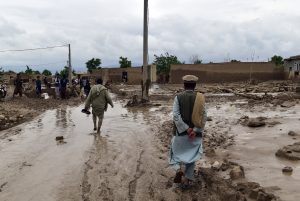When he heard that devastating floods hit his village in northern Afghanistan last week, farmer Abdul Ghani rushed home from neighboring Kunduz province, where he was visiting relatives. When he got home, he found out that his wife and three children had perished in the deluge.
Two of his sons survived but another son, who is 11, is still missing. “I couldn’t even find the road to my village,” he said, describing how he turned back and went another way to reach his district of Nahrin in Baghlan province.
Across Baghlan, others like Ghani and survivors of the disaster were still searching for their missing loved ones and burying their dead on Monday.
“Roads, villages and lands were all washed away,” Ghani said. His wife, his 7-year-old and 9-year-old daughters, and a 4-year-old son died.
“My life has turned into a disaster,” he said, speaking to The Associated Press over the phone.
The United Nations’ food agency estimates that the unusually heavy seasonal rains in Afghanistan left more than 300 people dead and thousands of houses destroyed, most of them in Baghlan, which bore the brunt of floodings on Friday.
Survivors have been left with no home, no land, and no source of livelihood, the World Food Program (WFP) said. Most of Baghlan is “inaccessible by trucks,” said the WFP, adding that it is resorting to every alternative it can think of to get food to the survivors.
U.N. Secretary-General Antonio Guterres has expressed condolences to the victims. He said a statement on Sunday that the world body and aid agencies are working with the Taliban-run government to help.
“The United Nations and its partners in Afghanistan are coordinating with the de facto authorities to swiftly assess needs and provide emergency assistance,” according to the statement.
The dead include 51 children, according to UNICEF, one of several international aid groups that are sending relief teams, medicines, blankets, and other supplies. The World Health Organization said it delivered 7 tons of medicines and emergency kits to the stricken areas.
Meanwhile, the U.N. migration agency has been distributing aid packages that include temporary shelters, essential non-food items, solar modules, clothing, and tools for repairs to their damaged shelters.
The latest disaster came on the heels of a previous one, when at least 70 people died in April from heavy rains and flash floods in the country. The waters also destroyed about 2,000 homes, three mosques and four schools in western Farah and Herat, and southern Zabul and Kandahar provinces.
Efforts to provide humanitarian aid to Afghanistan after such disasters are complicated by the fact that the Taliban’s interim government is not formally recognized by any other state or by the United Nations. The Taliban have also undermined relief efforts by banning women from working for both national and international aid agencies, including UNICEF, the WFP, and other U.N. programs. Many aid workers have pointed out that, due to the Taliban’s strict limits on women’s lives outside the home, female aid workers are often the only option to provide needed assistance to women and children.
In April 2023, when the ban on women in NGOs began to be implemented, UNICEF warned, “Female workers are vital to the success of our work. Without them, the humanitarian disaster unfolding inside Afghanistan will intensify, and more children will die.”

































